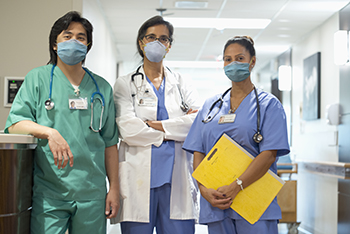Q&A on HICPAC’s process to update 2007 Isolation Guideline
Posted on by
One way CDC protects the nation’s health is through guidelines for healthcare settings that protect patients, providers, visitors, and staff from infection. These guidelines are developed through an extensive process of scientific review and stakeholder engagement. This year, one of CDC’s advisory committees, the Healthcare Infection Control Practices Advisory Committee (HICPAC), is reviewing and updating the 2007 Isolation Precautions guideline that helps keep healthcare workers and their patients safe from infections.
The guideline update process includes:
- Initial drafting of updated language by a workgroup of the committee.
- Input from agency and extramural experts.
- Public meeting for approval of a draft by the committee for submission to CDC for review.
- Posting of the draft language on the Federal Register for public comment.
- Review of public comments by CDC and the workgroup.
- Revision of the draft based on public comments.
- Public meeting for presentation of a proposed final draft to the committee for approval.
- If approved, CDC reviews the proposed final draft and if accepted will post the finalized update.
1. Why does the guideline need to change?
The goal of the revision is to provide the 23+ million healthcare workers in the Unites States with guidelines that are effective, up to date, practical in use, and safe and understandable. The guideline is 16 years old and 206 pages long, making it difficult for healthcare workers to apply quickly and making it susceptible to being misinterpreted. Some of the information is also out of date. HICPAC members and its workgroups have every patient, visitor, and healthcare worker in mind during these updates. This includes visitors, environmental services staff, respiratory therapists, administrative staff, nurses, and all others whose efforts help patients and residents receive the safe care they need.
2. Who will develop the new guideline?
HICPAC workgroups, convened by the committee in accordance with the Federal Advisory Committee Act, develop options for the full committee to discuss during public meetings. The full committee is charged with voting to send a guideline for consideration to CDC to present it for public comment.
Members and workgroups are made up of external (non-CDC) experts in fields including patient safety, occupational health, healthcare epidemiology infection prevention and control, and frontline patient care. Learn more about the current HICPAC roster. In addition, members of the public are invited and encouraged to participate in the process through the public comment period.
3. What changes do you expect?
The workgroup responsible for the first section has provided updates on their work at public HICPAC meetings since February 2022. So far, they have indicated that they are working to:
- Collapse and revise the 2007 content to provide more concise and approachable information.
- Include core concepts of how germs spread in healthcare settings and high-level summaries of personal protective equipment, or PPE (such as gloves, gowns, and masks), that healthcare workers can use to prevent or minimize the spread of infections.
- Update the categories of Isolation Precautions to better reflect how they are used to prevent pathogens from spreading in healthcare settings.
4. Will the new first section make new recommendations for respiratory viruses?
The revised first section will not include any recommendations for the types of precautions that should be used for specific pathogens. Pathogen-specific recommendations in the second section will be reviewed and updated starting in 2024, to inform the actions healthcare personnel should take, for example, for a patient with Ebola versus a patient with shingles.
5. When will the first section be available for public comment?
The first draft of the new first section will be presented to HICPAC for a review and vote at the public meeting November 2-3, 2023. This first draft and the meeting slides will be shared on the HICPAC website under the Upcoming Meetings tab. Following the meeting, the full meeting recording and the meeting minutes will be posted on the HICPAC website.
If HICPAC votes to approve the draft for CDC review, the first section will then be submitted to CDC where it will be reviewed as part of the clearance process, which includes program staff and Center leadership. If the draft is approved by CDC for posting for public comment, the draft will be posted to the Federal Register for 60 days for public review and comment (likely during November 2023-January 2024).
6. Will my comment be considered?
It is essential that individuals and organizations that have a comment review a copy of the draft in the Federal Register and make formal comments through that process. HICPAC reviews each comment made through the formal comment process. Comments are categorized by topic and will be presented along with suggested modifications in the public February 29 meeting in 2024. Public comments undergo a thorough review to determine where additional modifications and clarifications might be needed in the draft.
7. When will the first section be final?
The timing of the final guideline will depend on the public comment process and how long it takes to incorporate changes. The first section is not anticipated to be completed before June 2024. Learn more about How the U.S. updates its healthcare guidelines.
8. When will the second section be final?
Once the first section is complete, HICPAC will shift to the new second section: pathogen-specific recommendations. HICPAC and CDC will then review the makeup of the workgroups and solicit participation to ensure that the appropriate expertise is included for work needed on this next section. The recommendations workgroup will not begin until the first section is finalized, likely in 2024.
CDC will continue to provide updates on the progress of the workgroup and HICPAC discussion on the HICPAC website and on this blog. Learn more about the next scheduled HICPAC Meeting: Meeting Information | HICPAC | CDC.
Posted on by

